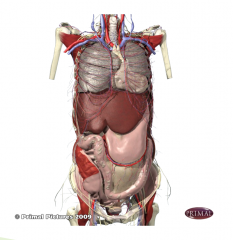![]()
![]()
![]()
Use LEFT and RIGHT arrow keys to navigate between flashcards;
Use UP and DOWN arrow keys to flip the card;
H to show hint;
A reads text to speech;
20 Cards in this Set
- Front
- Back
|
Size, shape and appearance of Liver |
Largest internal organ of the body (skin is larger, but external) Weighs around 1.5kg in adult Largest gland in the body (exocrine) Roughly triangular, with the apex on the left Right lobe is thicker ant/post than left lobe Deep reddish brown in colour |
|
|
Lobes of Liver |
Right lobe Left lobe Quadrate lobe (inferior part of centre of posterior aspect)Caudate lobe (superior part of centre of posterior aspect) Falciform Ligament divides left and right lobes |
|
|
Liver – Anterior View |

|
|
|
Liver – Posterior View |

|
|
|
Liver – Position in Abdomen |

|
|
|
Blood Supply to the Liver |
2 sources Hepatic Artery (from Abdominal Aorta) supplies 25% of blood Portal Vein (from digestive tract, spleen and pancreas) supplies 75% of blood Both enter the Liver at a point called the “Porta Hepatis” Venous drainage of the liver is via the Hepatic Vein to the IVC |
|
|
Liver functions |
The liver processes blood from the digestive tract, spleen and pancreas in order to: Produce bile to aid digestion Remove contaminants and toxins and excrete them in bile (carried out by Hepatocytes) Break down and destroy worn our red blood cells (carried our by Kuppfer cells – phagocytic). Bilirubin is also produced as a by-product of this process (gives bile its distinctive green colour) |
|
|
Liver functions (continued) |
Processing nutrients from digested food from intestine Storage of glycogen, fats and vitamins and control of levels of these in the blood stream Conversion of Ammonia to Urea Combating infection by destroying bacteria Activation of Vitamin D Hormone production and regulation (important in growth, platelet production, blood pressure and iron balance) Synthesises numerous blood proteinse.g. blood clotting proteins |
|
|
Bile Production |
Bile - up to 1L per daymixture of bilirubin and bile salts (made from cholesterol) Function of bileEmulsifies fats in chyme - breaks lipids down into small droplets for easier enzymatic digestion and absorption by intestinal wall |
|
|
Biliary System |
Gall Bladderfunction - stores and concentrates bile Biliary TreeFunction - drains bile from liver into duodenum or gall bladder |
|
|
Gall bladder – relevance to DI |
Diagnosis of gall stones and assessment of filling/emptying using ultrasound Endoscopic Retrograde Cholangiopancreatography (ERCP) post surgical removal of stones HIDA nuclear medicine scans to show patency and function of gall bladder and biliary tree |
|
|
Bile Storage |
Bile may be stored in the Gallbladder, a reservoir located behind the right lobe of the liver. When food containing fat enters the digestive tract it stimulates the release of Cholecystokinin (CCK), which in turn triggers the release of bile in to the Duodenum. Bile contains salts and enzymes which help emulsify the fat in the digestive tract. Bile also contains Bilirubin which gives faeces their distinctive colour |
|
|
Bile Production |

|
|
|
Gall stones |
Concentration of bile allows formation of stones made of crystallised salts Can block bile duct, causing excruciating pain after eating Gallbladder may have to be removed |
|
|
Jaundice |
May occur either from liver failure or from blocked bile duct. Excess Bilirubin circulates in the blood giving the skin and eyes a characteristic yellow colour Causes include Hepatitis, tumours, gall stones, Biliary Atresia, occlusion of bile duct by external pressure, and Cirrhosis of the liver. |
|
|
Neo-natal Jaundice |
This condition is due to the poor function of the liver in newborns. Generally it disappears as the infant matures but severe cases can be treated with blue-light therapy |
|
|
Liver Function Tests |
Liver function may be compromised by high doses of chemotherapy LFT’s check levels of liver products such as albumin and bilirubin in the blood High blood levels show liver is not functioning properly May also indicate liver failure from many other sources, e.g. Cancer, Cirrhosis, etc. |
|
|
Pancreas |
UNIQUE FEATURE! Mixed endocrine and exocrine gland Retroperitoneal Up to 15cm long Head, body and tail Head rests in concavity of Duodenum Tail extends to left behind stomach |
|
|
Pancreas – relevance to DI |
Diagnosis of pancreatic cancer – CT/US ERCP – need to avoid injecting contrast in to pancreatic duct as causes pancreatitis Diabetes – common condition, may affect patients, staff and other members of the public |
|
|
Pancreas Exocrine functions |
the parasympathetic nervous systemThrough the vagus nerve (X) – stimulates secretion of Secretin This results in release of pancreatic juice and digestive enzymes Secretes >1L of pancreatic juice daily bicarbonate - alkaline digestive enzymes |

